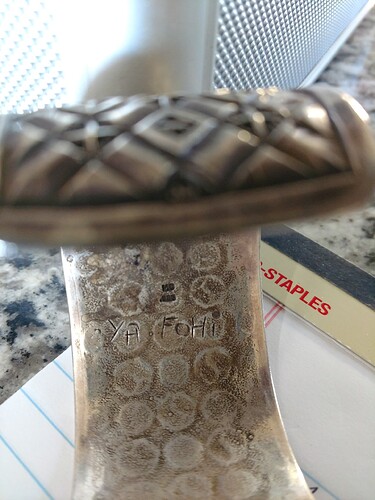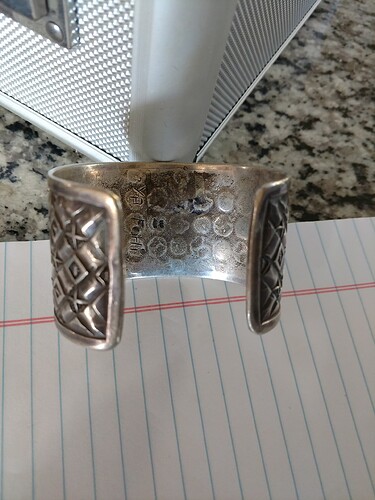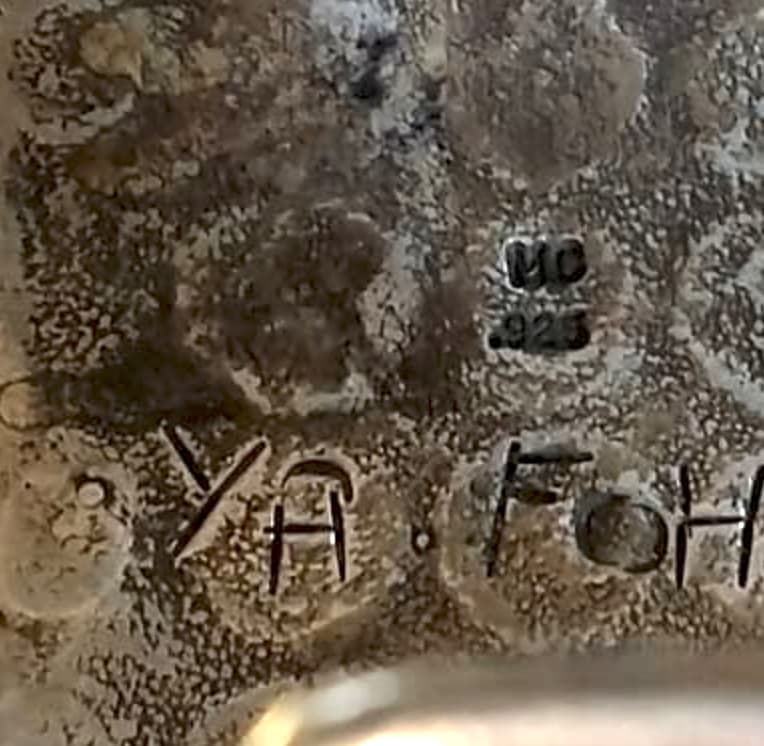Could any of y’all help me with this hallmarked silver cuff.
Stamped “YAF HI” Could the HI stand for HOPI?
Is it cast?
Very large, heavy and old.
I always appreciate the vast knowledge from everyone here on this forum.
Best place ever to hang out.
That does not look like a Hopi piece, so I would say it does not.
It is gorgeous.
How old do you mean?
My opinion, I’m thinking African nation, possibly Senegal or Ivory Coast thinking it may be a tribute to the work of Seydou Kone. That being said, I have seen similar designs from Israel.
@StevesTrail What makes you think so? Some comparables or design points you can share?
–
It’s hallmarked MC .925, which is the indicator of its maker, but to me unrecognizable (and nothing relevant in Hougart’s). The incised letters aren’t a guide to the artist and for sure don’t indicate Hopi.
@chicfarmer, I edited my response finishing my thoughts on the bracelet.
Sorry, still don’t understand. Seydou Kone is an athlete, not a jeweler, so it doesn’t lead me visually to anything. I was asking about jewelry or design elements that remind you of this bracelet, so we can grasp the idea behind a suggested origin.
Anyway, I think it could be Navajo, though unusual. I’ve seen stamping like it, and it has a kind of Navajo rug pattern effect though in relief. I’m never inclined to guess Navajo with a .925 stamp, but our own Sir Michael of Rogers has corrected me. ![]()
Agree about the .925 not seen much on Native work, but my Milford Calamity (Navajo) ring is stamped .925, although I think it’s the only piece I have stamped that way.
It is an interesting cuff.
I imagine more explanation is warranted as I failed to explain myself adequately. I must admit that my interests tend toward history and the arts rather than modern sports and so do my references. As such, @chicfarmer informed me of an athlete by the name of Seydou Koné, of which I was unaware. The Mr. Koné I refer to is the Ivorian reggae singer, songwriter, and (in my opinion) political activist that goes by the stage name “Alpha Blondy”. With that being said, I am remiss for not including his stage name in my earlier post which would have eliminated some of the confusion. He even has a Wikipedia page (I just checked). His bio is worth reading, (sorry, no athletics for you sports lovers).
I hate to run on but I guess I must so please bear with me. My origin reference. Over the past 30 years, hundreds of pieces of jewelry from all over the world have past through my hands, most of them sterling. I can say with confidence that the tiny “MC 985” (as I read it) is more consistent with common international marked sterling jewelry than with Native American pieces I am familiar with.
I apologize for any confusion. My intent was not to make someone “understand” design and style as I believe that perception is reality. Whether a person sees a Navajo pattern, a checkerboard, or an aberration is not mine to dispute. All I can offer is that I have seen this type of pattern jewelry in pieces made outside the USA.
Now to my Alpha Blondy reference. I noticed someone did their best to stamp the phrase “YA FOHI” (as I read it) on the underside of the bracelet. From what I know, that phrase points directly to Alpha Blondy. If I were to speculate, perhaps the pattern reflects Alpha Blondys’ attempt at unity between Islam, Judaism, and Christianity (just a wild guess on my part). Perhaps it was worn by an activist, supporter, or just a fan, or maybe none of the above and has no ties whatsoever to Alpha Blondy.
I only endeavor to offer an alternate path for research. I feel that the piece should tell us its story, not fit what we want it to be.
Interesting info, thanks. All of us here are on this forum because of interest in the arts and history, clearly, so the company is well shared. I hadn’t heard of the name you mentioned and that’s one that turned up.
Gorgeous work!
This is a modified basket weave pattern of the type used in saddlery and leather work. The tooling and the way the tooling is used is identical to that used in leatherwork. Particularly interesting is the wide bevel stamp used to create recessed and raised areas within the basket weave design. I’d be inclined to guess this is work of a cowboy saddle maker, or leather worker who also works in silver.
Oh my - now you guys have me more confused than ever!
I do appreciate all the thoughts on this unusual piece.
If only they could talk…
Welcome to the club!
MC looks like the maker’s mark, and would likely have been applied along with the quality stamp before the design stamp and bevel work was done. The larger characters spelling “ YA FOHI” were crudely formed with a small straight and small curved stamp, and do not correspond at all with the professional attention to detail and quality of stamp work used by the maker. This was most likely applied well after the piece was made, by an unrelated third party, for unknown reasons. IMO this is not a maker’s mark.
The fact that it is marked 985 rather than 925 is interesting and does make me wonder if came from outside the US.
This is an enlargement of the hallmark. Tarnish distorted it somewhat but it’s .925. (I had misread the initials at first.)
The other possibilities I was thinking about are Thailand, and Indonesia. Given the style I think Thailand would be the more likely.
Without a paper trail, origin is a real crap shoot. The techniques used go back to antiquity (Roman Empire and earlier) and are used the world over. The Hallmark “MC” looks like a Western (Europe or US) makers mark.
Great enlargement and clarification @chicfarmer. I couldn’t pick the 925 up clearly. I agree with @mmrogers that the YA FOHI was by a third party and that Thailand is also a good option.
You are right now that I examine it even more closely - it is 925.
Thanks to everyone here that put their two cents in!
JP





